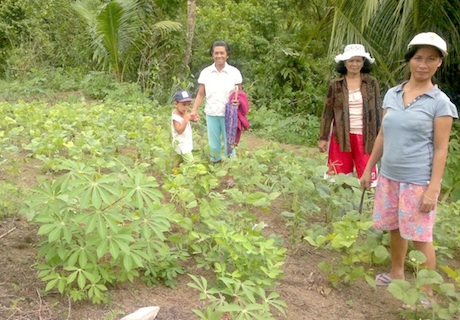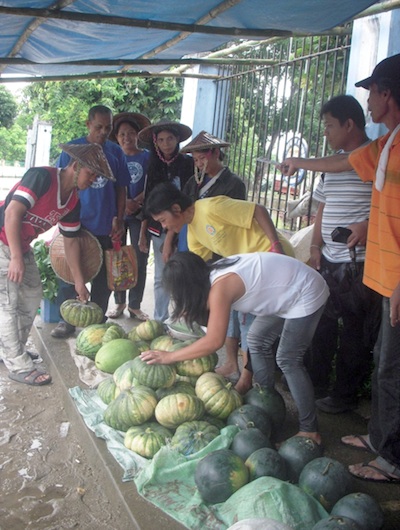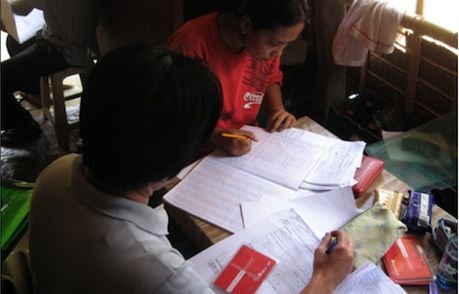Overview:
This project aimed to educate families about organic crops and alternative farming techniques, enabling them to grow a diverse range of nutritious organic food to eat and sell. Access to a greater range of quality food will help to reduce child malnutrition in Northern Samar, which has the country’s highest child mortality rate.
Project Activities:
Plan has established 20 Farmers Associations and 22 demonstration farms to assist farming families learn new skills. The farms have also served as ‘laboratories’ where all farming experiences are shared. Over 500 farmers have received training and have been able to achieve increased productivity for their root crops.
Distribution of small farm machineries, including hand tractors, also helped to increase farm productivity.
Plan has established Seed Banks to the 20 Farmers Associations to ensure continuous collection of locally adoptable seeds and materials for the following season.
Livestock such as water buffalo, pigs and chickens were provided to the farmers to provide additional household income and to serve as work animals during land preparation activities.
Adoption of a diversified and integrated farming system has increased family production of consumption and additional income.

Photo: The women of Las Navas in their communal farm.
Case study: Isabela-Rowena Gancena
Rowena Gancena is 48 years old and married to Julio. They have 8 children; the eldest is 25 years old while the youngest is 3 years old. Their main source of livelihood is farming; they own 1 hectare rice field. The family have been part of the Sustainable Livelihoods project.
“There are a lot of good things that organic farming has given us. Expenses in our farm work have been reduced, and I am healed of my sickness. Before, I always have headache and felt chest pains. I thought I will die because I cannot bear the terrible pain.
When my husband was first trying out organic farming, I strongly opposed this because we have good harvest then from our farms. I worry that our produce will decrease and there will not be enough supply for our food. I was even the one who bought the chemicals that he used in spraying and did the storing. I endure the stinky smell of the chemicals because we rely on it in killing the pests.
However, my husband persisted and continued to shift to organic farming. True enough, after so many croppings, our rice harvest was better than before.
After a year of eating organic rice and vegetables I no longer have headaches and felt chest pains which I have been suffering before. Maybe this is because of the healthy food that we eat and not being exposed anymore to chemicals.
Even my children now only eat organic food that we produce because we are sure that it was not sprayed with chemicals. We no longer buy vegetables in the market. My children say that they don’t easily get hungry when they eat organic food. My children are healthier now. They don’t suffer from diarrhoea like before, and they don’t easily get sick.”
Rowena Gancena
The future of this project
The project will continue through to conclusion in late 2013. The Farmers Associations will be self managed, but the provincial government of Northern Samar is supporting the local government in mainstreaming this project.

Photo:
Farmers of San Roque sell organic squash during the celebration of Nutrition Month.
Project objective
1. To increase farm production and child nutritional levels through the adoption of sustainable farming techniques.
2. To increase the capacity of farmers associations to effectively provide services to their members.
3. To increase income levels of farmers through marketing of sustainable agriculture products.
What’s covered in project cost?
This funding will go towards training the farmers in sustainable farming techniques. This includes training at a farmer training centre, ongoing mentoring and support on-site at the farmers’ communal and individual farms, and the provision of farming equipment, seeds and small livestock.
Background into the current situation
Infant mortality and child malnutrition are significant problems in the Philippines, particularly in Northern Samar where 79 of every 1000 children die before their fifth birthday. Most families are subsistence farmers trapped in poverty by a cycle of poor rice yields and depleted soils, and crops often damaged by drought, floods and typhoons. Families then become caught in a cycle of debt as they struggle to feed themselves, let alone pay for school fees and healthcare.
This project educates families about organic crops and alternative farming techniques, so that they can grow a diverse range of nutritious, organic food to eat and sell. Access to a greater range of quality food will also help to reduce child malnutrition in Northern Samar, which has the country’s highest child mortality rate.

Photo: A boy showing his families crop of beans. Through diversifying the types of food produced families are able to increase production which means better nutrition and more income.
What is Plan doing?
Plan works through 20 established Farmers Associations to assist farming families to learn new farming skills. This five-year project will benefit 10,000 families by strengthening the Farmers Associations and helping farmers to share skills and market their produce. With our support, the associations have established community demonstration plots to practice what they have learnt through the project and to introduce other farmers to alternative crops and new techniques that help to increase crop quality and yield. All association members tend to the plots and share in the resulting harvest.
Results so far
A mid-term project evaluation revealed that farming families are now enjoying increased productivity and income. Last year, 543 farmers received training, and we also helped them to develop annual farming plans so that they can better organise their resources, resulting in more efficient use of land and maximised productivity.
Each Farmers Association also nominated three members to become para-technicians, with 60 farmers receiving further training on new technologies such as soil and water conservation and how to produce organic fertilisers for their crops (a non-chemical, healthier and cheaper alternative). The para-technicians are now responsible for teaching fellow association members these new techniques and skills.
Raising livestock diversifies farming income
Plan has also assisted farmers to raise livestock such as pigs and chickens, which has provided families with an additional income source and made them more resilient – for if their crops are wiped out by floods they still have an income from their livestock.
To ensure farmers are able to use the skills and knowledge they have gained, one of Plan’s partners provides mentoring and support during regular visits to Farmers Associations.
And as the area is prone to extreme weather conditions, farmers have been encouraged to introduce durable crops that are more likely to withstand heavy rains and high winds. The Farmers Associations also established rice demonstration plots where they are now testing different seeds to select the most appropriate rice type for the area’s unforgiving climate.

Photo: A female farmer learning how to manage the books so she can have a greater return on investment from her farming activities.